JBoss Dashbuilder
- Objectives
- Deploy dashboard-builder to WildFly
- Security configuration in web.xml
- Use Mysql with dashboard-builder
- ControllerServlet
Objectives
This article is a supplement of Dashbuilder’s document on dashbuilder.org and github.com/kylinsoong/dashboard-builder, primary purpose including:
- Build Dashbuilder from source code
- Debug source code under dashboard-builder.
- Trial Dashbuilder on WildFly
Deploy dashboard-builder to WildFly
Build from source code
$ git clone git@github.com:kylinsoong/dashboard-builder.git
$ cd dashboard-builder/
$ mvn clean install -P h2,jetty -DskipTests
$ cd builder/
$ mvn clean install
Execute above commands will generate dashbuilder-VERSION-wildflyX.war under ‘dashboard-builder/builder/target’ folder, this war need deploy to a running WildFly Server.
Create User
Navigate to WildFly Home, execute the following commands to create two user:
$ ./bin/add-user.sh -a -u root -p password1! -g admin
$ ./bin/add-user.sh -a -u user -p password1! -g user
Run the Dashboard Builder
Once WildFly id running, dashbuilder-VERSION-wildflyX.war deployed success, login Dashboard Builder via
http://localhost:8080/dashbuilder
and use the recently created user root/password1! as below figure:
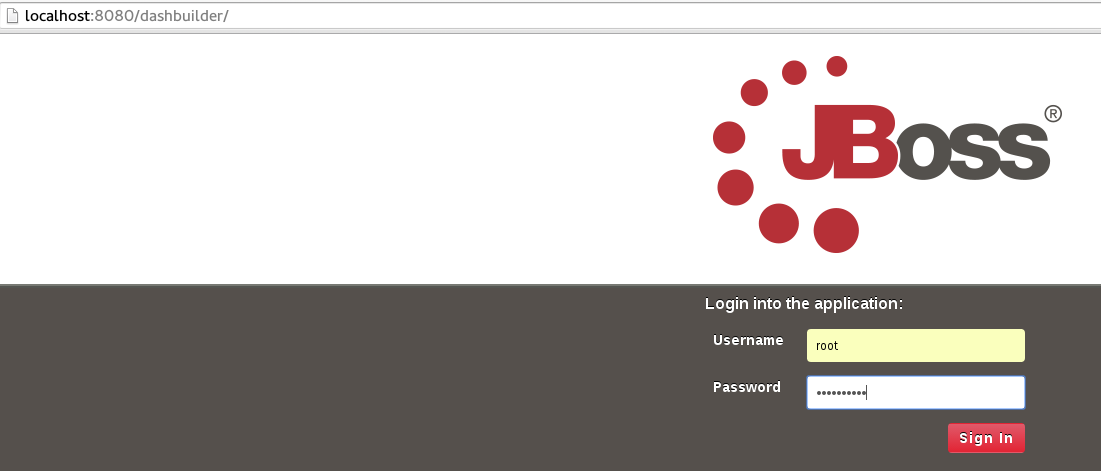
Security configuration in web.xml
<security-role>
<description>Administrator</description>
<role-name>admin</role-name>
</security-role>
<security-role>
<description>End user</description>
<role-name>user</role-name>
</security-role>
<security-constraint>
<web-resource-collection>
<web-resource-name>Free access</web-resource-name>
<url-pattern>/images/jb_logo.png</url-pattern>
</web-resource-collection>
</security-constraint>
<security-constraint>
<web-resource-collection>
<web-resource-name>Restricted access</web-resource-name>
<url-pattern>/*</url-pattern>
</web-resource-collection>
<auth-constraint>
<role-name>admin</role-name>
<role-name>user</role-name>
</auth-constraint>
</security-constraint>
<login-config>
<auth-method>FORM</auth-method>
<form-login-config>
<form-login-page>/login.jsp</form-login-page>
<form-error-page>/login_failed.jsp</form-error-page>
</form-login-config>
</login-config>
<error-page>
<error-code>403</error-code>
<location>/not_authorized.jsp</location>
</error-page>
-
security-role - lists all the security roles used in the application, these roles should be mapped with roles exist in Application Server, in WildFly, map roles to a specific appication via
security-domainwhich defined injboss-web.xmlfile. -
security-constraint - define the access privileges to a collection of resources using their URL mapping. web-resource-collection specifies a list of URL patterns, auth-constraint specifies whether authentication is to be used and names the roles authorized to perform the constrained requests.
-
login-config - define authentication method, in above configuration, Form-based authentication be defined, refer to below
Form-Based Authenticationfor more details.
Form-Based Authentication
Compare with Basic Authentication pop up a raw login form, Form-Based Authentication allows the developer to control the look and feel of the login authentication screens by customizing the login screen and error pages that an HTTP browser presents to the end user. As below figure:
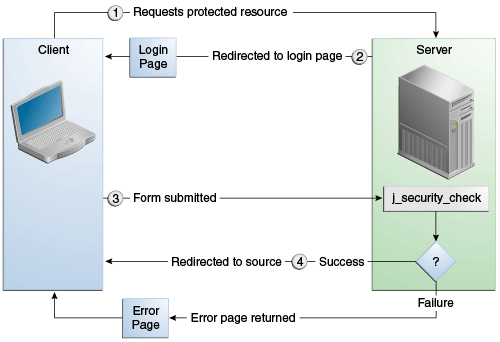
When form-based authentication is declared, the following actions occur:
- A client requests access to a protected resource.
- If the client is unauthenticated, the server redirects the client to a login page.
- The client submits the login form to the server.
- The server attempts to authenticate the user. If authentication succeeds, redirect to requested protected resource, If authentication fails, redirected to an error page.
An example of login form:
<form method="POST" action="j_security_check">
<input type="text" name="j_username">
<input type="password" name="j_password">
</form>
Note that, the action of the login form must always be j_security_check, the input name must be j_username and the input password must be j_password.
Use Mysql with dashboard-builder
ControllerServlet
ControllerServlet is the entry point for UI request, all request(/workspace/, /jsp/, /kpi/*) will go to ControllerServlet, below figure is the sequence diagram of dashboard-builder login:
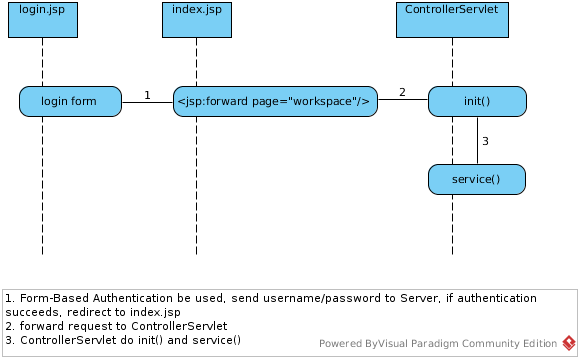
web fragment
Started from Servlet 3.0, web-fragment.xml be introduced for pluggability of library jars which are packaged under WEB-INF/lib, The content of web-fragment.xml are almost same as web.xml, the web-fragment.xml be placed under classpath’s META-INF folder.
For example, in dashbuilder.war’s index.jsp define a jsp forward to Servlet
<jsp:forward page="workspace"/>
workspace define in WEB-INF/lib/dashboard-ui-core-6.4.0-SNAPSHOT.jar/META-INF/web-fragment.xml, rather than wewb.xml, the workspace definition looks:
<servlet>
<servlet-name>Controller</servlet-name>
<servlet-class>org.jboss.dashboard.ui.controller.ControllerServlet</servlet-class>
<load-on-startup>5</load-on-startup>
</servlet>
<servlet-mapping>
<servlet-name>Controller</servlet-name>
<url-pattern>/workspace/*</url-pattern>
</servlet-mapping>
ControllerServlet init
The following will dive into ControllerServlet init.
init App Directories
The following 3 directory path be formed and set to @ApplicationScoped scope entiry org.jboss.dashboard.Application:
- baseAppDir -> standalone/deployments/dashbuilder.war
- baseConfigDir -> standalone/deployments/dashbuilder.war/WEB-INF/etc
- baseLibDir -> standalone/deployments/dashbuilder.war/WEB-INF/lib
Key code used to extract baseAppDir:
baseAppDir = new File(getServletContext().getRealPath("/")).getPath();
Startable Start
The Startable happens in ControllerServlet init, the sequence like
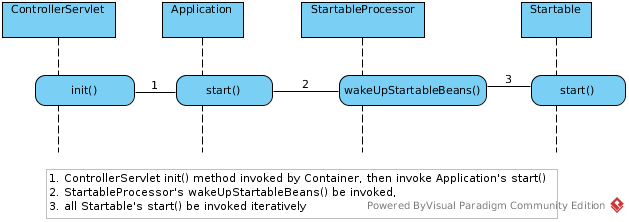
All 10 Startable be started including:
org.jboss.dashboard.database.hibernate.HibernateInitializer
org.jboss.dashboard.security.UIPolicy
org.jboss.dashboard.workspace.PanelsProvidersManagerImpl
org.jboss.dashboard.workspace.SkinsManagerImpl
org.jboss.dashboard.cluster.ClusterNodesManager
org.jboss.dashboard.workspace.LayoutsManagerImpl
org.jboss.dashboard.ui.resources.ResourceManagerImpl
org.jboss.dashboard.workspace.EnvelopesManagerImpl
org.jboss.dashboard.DeploymentScanner
org.jboss.dashboard.initialModule.InitialModulesManager
Hibernate cfg
Startable HibernateInitializer start initializes the Hibernate framework. It reads all the *.hbm.xml files and push them as part of the Hibernate configuration. Furthermore, initializes a SessionFactory object that will be used further by transactions.
dashbuilder.war’s total 16 .hbm.xml files be placed in 7 places:
1. dashbuilder.war/WEB-INFO/etc
hibernate.cfg.xml
2. dashbuilder.war/WEB-INF/lib/dashboard-security-VERSION.jar
org/jboss/dashboard/security/PermissionDescriptor.hbm.xml
3. dashbuilder.war/WEB-INF/lib/dashboard-commons-VERSION.jar
org/jboss/dashboard/cluster/ClusterNode.hbm.xml
org/jboss/dashboard/database/InstalledModule.hbm.xml
org/jboss/dashboard/database/DataSourceEntry.hbm.xml
4. dashbuilder.war/WEB-INF/lib/dashboard-provider-core-VERSION.jar
org/jboss/dashboard/provider/DataProvider.hbm.xml
5. dashbuilder.war/WEB-INF/lib/dashboard-ui-core-VERSION.jar
org/jboss/dashboard/ui/resources/GraphicElement.hbm.xml
org/jboss/dashboard/workspace/Section.hbm.xml
org/jboss/dashboard/workspace/PanelInstance.hbm.xml
org/jboss/dashboard/workspace/PanelParameter.hbm.xml
org/jboss/dashboard/workspace/Panel.hbm.xml
org/jboss/dashboard/workspace/Workspace.hbm.xml
6. dashbuilder.war/WEB-INF/lib/dashboard-displayer-core-VERSION.jar
org/jboss/dashboard/kpi/KPI.hbm.xml
7. dashbuilder.war/WEB-INF/lib/dashboard-ui-panels-VERSION.jar
org/jboss/dashboard/ui/panel/advancedHTML/HtmlCode.hbm.xml
org/jboss/dashboard/ui/panel/dataSourceManagement/DataSourceColumnEntry.hbm.xml
org/jboss/dashboard/ui/panel/dataSourceManagement/DataSourceTableEntry.hbm.xml
Using Hibernate Service API create SessionFactory
The key Hibernate API used in dashbuilder to init the SessionFactory looks

- 第 2 - 3 行实例化一个
org.hibernate.cfg.Configuration对象,加载 Hibernate 配置文件 *.hbm.xml - 第 4 - 5 行通过
org.hibernate.service.ServiceRegistryBuilder实例化一个org.hibernate.service.ServiceRegistry - 第 6 行创建 SessionFactory
Completed runable code refer to HibernateInitializerH2
Using Hibernate Session execute JDBC operations
The org.hibernate.Session can be used to execute JDBC operations, it looks
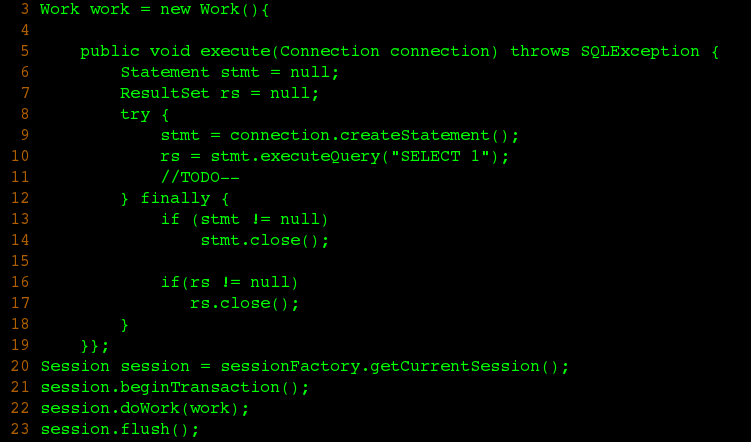
- 第 2 - 19 行实例化了一个
org.hibernate.jdbc.Work,execute(Connection connection) 方法用来执行 JDBC 操作 - 第 20 行通过 sessionFactory 创建一个
org.hibernate.Session - 第 21 - 23 执行 Work,重写的 execute(Connection connection) 方法被调运